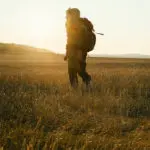A good survival kit is a must in every person’s life because, in such a dynamic age as ours, you never know what can happen and when. A first aid kit or a small stainless steel blade can come in handy on almost every occasion – from an earthquake to a hurricane.
So, to increase your emergency preparedness level, we will show you what should be found in the best emergency survival kits on today’s market, how to use them, and what essential items to look for in them.
1. Emergency Zone 72-Hour
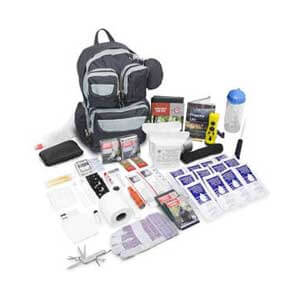
It may appear as nothing particularly special, but this bug-out survival kit is all you need to be wrapped in a neat, not-so-little package that will serve you in an emergency. To start with, the only things you will need to include are personal items because the pack has a multifunctional stainless steel Swiss army knife, a survival guidebook, а survival rope, and a dynamo-powered flashlight plus a radio combo.
The shelter wouldn’t be much of a hassle either because you have sleeping bags and emergency ponchos. The kit also includes a three-person tube tent and hand warmers to make sure you retain your dryness and body heat.
Next, we have enough food and water supplies for two people to survive comfortably for 72 hours and double the time if you are alone. Two five-year shelf-life energy bars for 3600 calories are paired with twelve 4.2 oz water pouches that are going to be just enough to make you stop worrying about supplies for a bit.
Hygiene is taken care of with a comprehensive pack of things like a toothbrush, soap, a sewing kit, and shampoo will help you stay clean or clean your wound if the situation calls for it. While it is very sizable, the bag has a discrete design to help you blend in because you never know what people you can encounter in the city. And what’s more, the bag has an additional chest strap for added support and а breathable mesh back.
The twelve additional pockets add a bit more versatility to your bag, and the large main pocket makes the bag big enough to store anything you are going to need.
Suffice it to say – this survival kit has everything you want and more. While its high price point and larger size may be a turn-off, you can’t find anything as good as this at this price. Its bulkiness won’t be a problem if you use it in an urban environment. With a little customization, it can be your irreplaceable companion in every emergency out there.
Pros
- While it may be a little too big, it has everything that you may need, no matter the situation
- There is not only water and food supplies but also a competent shelter inside
- Everything in it is made to last so that you can put it into the back of your car without any worry
Cons
- Because of its urban nature, it doesn’t have a fishing kit
- It may have a lot of stuff in it, but that makes it pretty heavy and thus not very good for survival situations outdoors
2. My Medic – MyFAK Kit
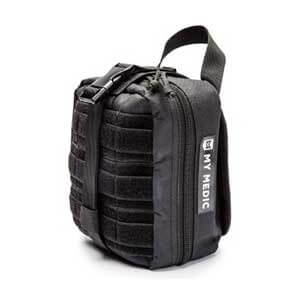
My Medic medical kit is the most versatile of its kind, equipped with over 200 items. It is simple and practically indestructible.
Inside, you will find products such as cold packs, splints, sprain and fracture mods, penlight, tweezer, tape, thermometer, thermometer sheaths, bandage assorted packs, pads, different medication, hand sanitizer, antiseptic wipes, gloves, whistle, and so much more.
Its containment bag is made out of ballistic nylon, it’s weatherproof, and it also has a heavy-duty handle to give you more secure carrying. There are also two D–rings for strap attachments so you can carry it over your shoulder, and the instant access Velcro opened compartment means you won’t lose any time trying to open the bag.
The exterior shell will serve you in any possible situation, and the filling of this cake is even better.
It has anything from anesthesia to surgical scissors, band-aids, and even more commonly found medicine like aspirin. This kit is a little bit on the thicker side with its 4 inches of depth. However, it isn’t significant to be cumbersome while still having everything you want from a first aid kit.
Pros
- It is the most comprehensive pack when it comes to healing wounds
- The case is as amazing as the contents, durable and multifunctional
- It is lightweight, for all the different things that it has inside
Cons
- While it may not weigh much, it still takes a fair amount of space with its 4 inches of depth
- There have been many reports of missing or leaking packets
3. Wise Food Emergency Kit
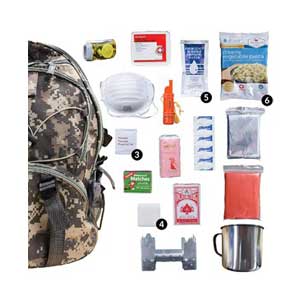
If you go on little adventures a lot, you know that the outdoors can be a thrilling but dangerous place. So if you are the type of person that seeks these thrills, get yourself an urban and specialized survival kit for the great outdoors.
The Wise Food survival kit is perfectly tailored for more extreme conditions due to its aid supplies. It is rugged and bulky, but it is a must if you are planning to go further than you ever had before or to be safe even in places you’ve been to countless times.
This particular survival kit is made for prolonged use – the provisions it includes, the portable stove and the comprehensive first aid kit, will serve them for up to five days and, with careful use – even more. The portable stove has 24 fuel tablets, thus making it easy to transport in your backpack and a perfect tool for keeping warm or boiling water and cooking food. And the food is excellent! The survival kit includes 32 gourmet servings, such as hearty soups, cereal, pasta, and milk.
This pack is the five-day Swiss Army Knife of the survival kits. With delicious food, useful tools such as masks, gloves, an emergency blanket, and even a deck of playing cards for some fun activities, there isn’t a thing missing to keep you safe even in the most desperate of emergencies.
Pros
- It has all the necessary items to survive in the wild for a couple of days
- It is made for prolonged use, with all the important gear to make a shelter
- While it is bulky and rugged, it remains pretty lightweight
Cons
- The backpack itself is made with cheap fabric that unravels too fast
- There is a huge contradiction in the design – all of the food requires water to be prepared, but there isn’t enough water for five days
4. Sustain Supply Co. Kit – Comfort 2
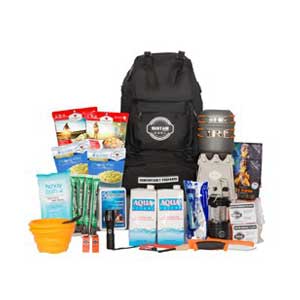
If you are a two-person family, or maybe you’ve gone hiking with a friend, this Sustain Supply Co. survival kit is one of the best choices for you.
With real food, clean water, and quality tools, you and a loved one will be prepared for anything the elements might throw your way. The amazing value of Comfort2 is that it is designed to help you stay calm and comfortable in a disaster situation.
The essentials are all here, but there are some standouts. There is a Morakniv knife, which is one of the best survival knives in the market, two Aqua Liters refillable water cartons, and a portable stove with two bowls with utensils included. Inside, you can also find the essentials for any survival situation, which include 12 Wise Company food servings, 2 liters of aqua water, sustain survival straws, Cyalume snap lights, a LED lantern, a fully stocked first aid kit, a thermal blanket, a bath wipes pack, ferrocerium rod, whistles.
It is a three-day supply option, and if you are a two-person team, this survival kit can do wonders in your future adventures or most emergencies and crises.
Pros
- This pack is designed to support two people, so it is perfect for a young family
- There aren’t survival items but also gear, like a Morkniv knife and food utensils
- It is super compact, but it will still last you three whole days
Cons
- The carton boxes for the water are too fragile
- There have been a large number of reports of missing items
- The food that comes with the pack won’t last you too long, and it probably is two or 3 years too old
5. Emergency Zone Prep Kit
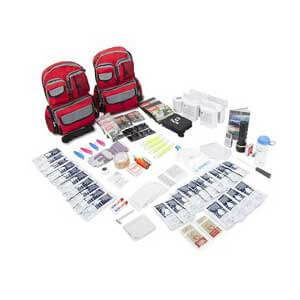
Next, we have a product from Emergency Zone that is a perfect solution for the whole family in an emergency. The entire survival kit is divided into two red discrete heavy-duty backpacks. They are lightweight, won’t draw any unwanted attention, and still have space for personal items and customization.
It includes all of the useful items from the brand’s Urban Survival 72-Hour survival kit while changing some things like doing a rubber flashlight and just having more of everything.
Overall, this family-inclusive option comes with 118 pieces of first aid kit, food, and emergency drinking water, survival gear (rope, can opener, whistle, emergency guidebook, tape, and gloves), light and communication tools (glow sticks, batteries, and radio), weather protection gear (reflective sleeping bags, emergency ponchos, tube tent, and hand warmers), hygiene and sanitation products (toothbrush, toothpaste, comb, razor, shampoo, shaving cream, soap bar, feminine pads, washcloth, paper roll, and a sewing kit), as well as water purification tools (folding water container, water purification powder, water bottle, and water filter straw).
All of this is the best option to keep your whole family safe. The big and comfortable backpack, the included guide, and all of the provisions and tools you may need to make this survival kit your most viable choice.
Pros
- It packs all the needed survival items for a whole family of four in a normal size backpack
- It will last you three whole days, with food, water, and general provisions to survive safely
- The kit also makes sure to include quality pieces of gear to complement the provisions
Cons
- The included flashlight is almost useless, extremely cheaply made
- While it is an excellent base, it is hugely advisable that you customize it
How to choose the best survival kit?
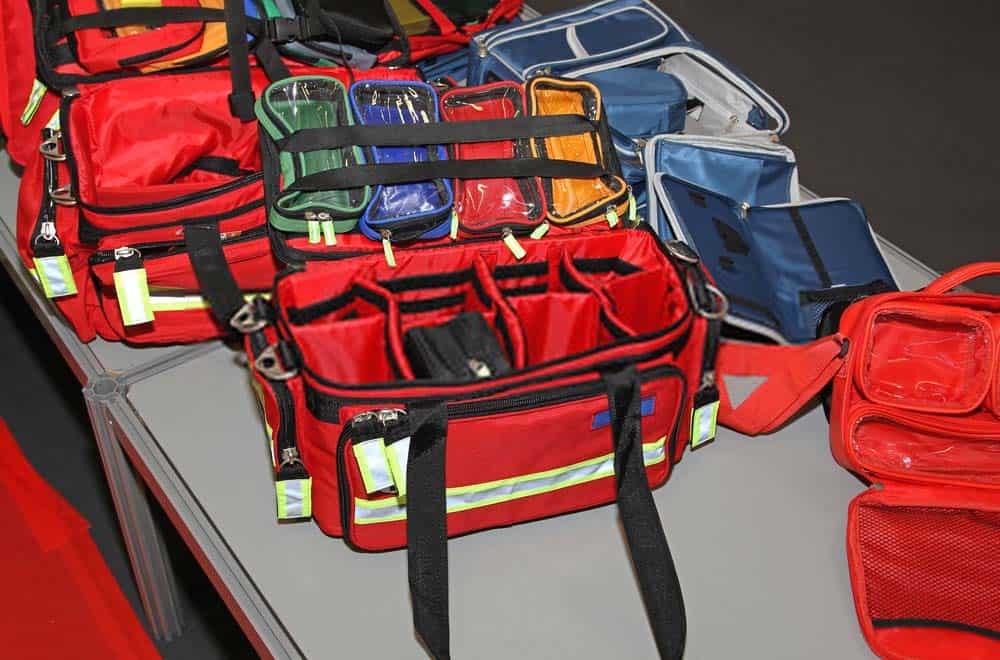
The two most important factors for all survival kits are their contents and size. Although some may say there are specialized ones for certain occasions, in the standard emergency kit, there is enough versatility to help you not only in flood but also in case you get lost during a hike, for example. Therefore, we will list all the pieces that make a survival kit the package to save your life in even the most desperate situations.
Size
The size of your survival kit determines two significant factors – its portability and longevity. For example, the official site of the red cross states that ‘you should have at least 1 gallon of water per person per day’, so you should consider how many people will use the kit and for how long.
So to wrap it up, a standard survival kit should be enough for three to four days if you are alone, but if you are a two-person family, you could probably last a maximum of two days. A family man should consider one of the many available families sized kits out there.
Though you may think bigger is always better, here, this isn’t the case. While more supplies are better in some instances, the less you carry, the more mobile you are. So if you are alone, you shouldn’t bring a massive suitcase full of supplies you may not even get to use.
Suffice it to say even if you are alone against the forces of nature, a big and expensive survival kit will do more harm than aid. You should get your priorities straight and stick to only what’s crucial in as small as possible package, even as small as a tiny survival bracelet. Unless you have the training and experience to survive and help others, you should consider some of the more advanced features of the bigger kits.
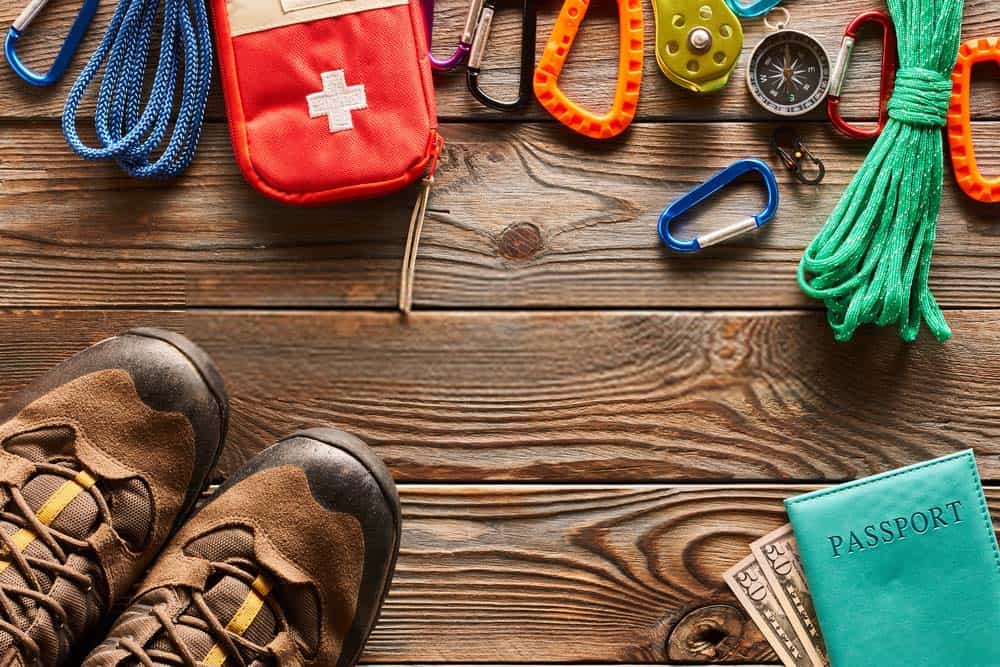
A good kit is your best companion in an emergency. So, the items that it includes could make or break it. While some things are necessary, you shouldn’t be afraid of customization. There are а couple of irreplaceable tools, which I will list below.
Emergency Food & Water
When you hear survival kit, the first thing you imagine is maybe something like a bushcraft knife, duct tape, or an emergency blanket, but you should think about what your body needs the most, which is food and water.
The red cross suggests supplies for three days in case of an emergency and two days if you are at home. As we mentioned above, your water should be at least a gallon per person for a day, and your choice of meals should be non-perishable, easy-to-prepare food.
Water Filters & Tablets
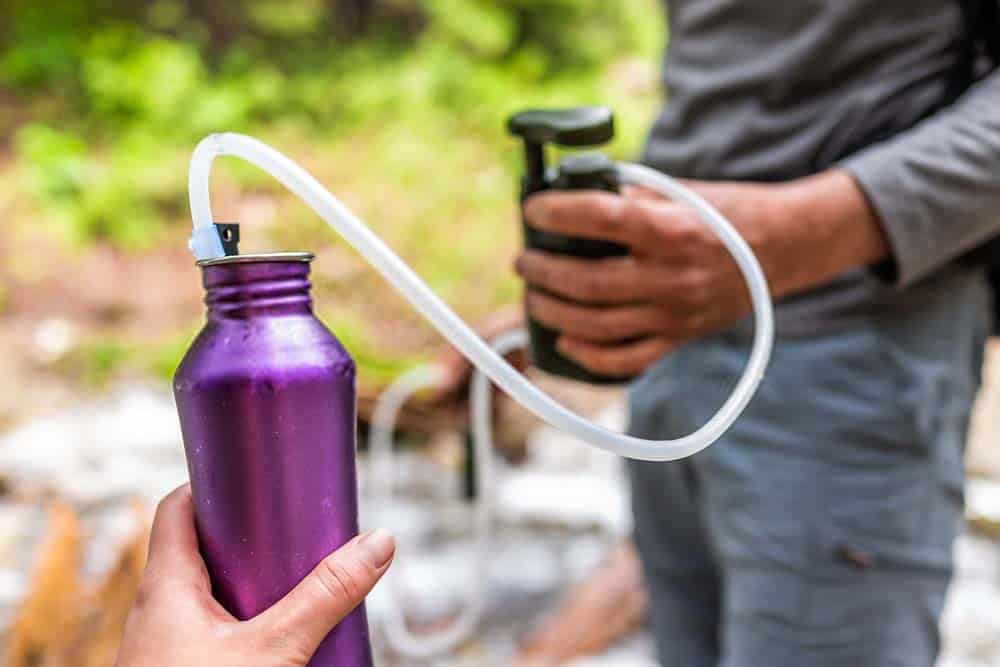
Water is a thing you can’t replace, no questions asked. So, even in everyday life, you should ensure that you drink clean water, and in case of an emergency, it should be one of your top priorities. Water tablets, more specifically iodine ones, take little to no space in your survival kit, so they should be the first thing you add. Water filters work even faster and are great for both outdoor and home emergencies.
Food
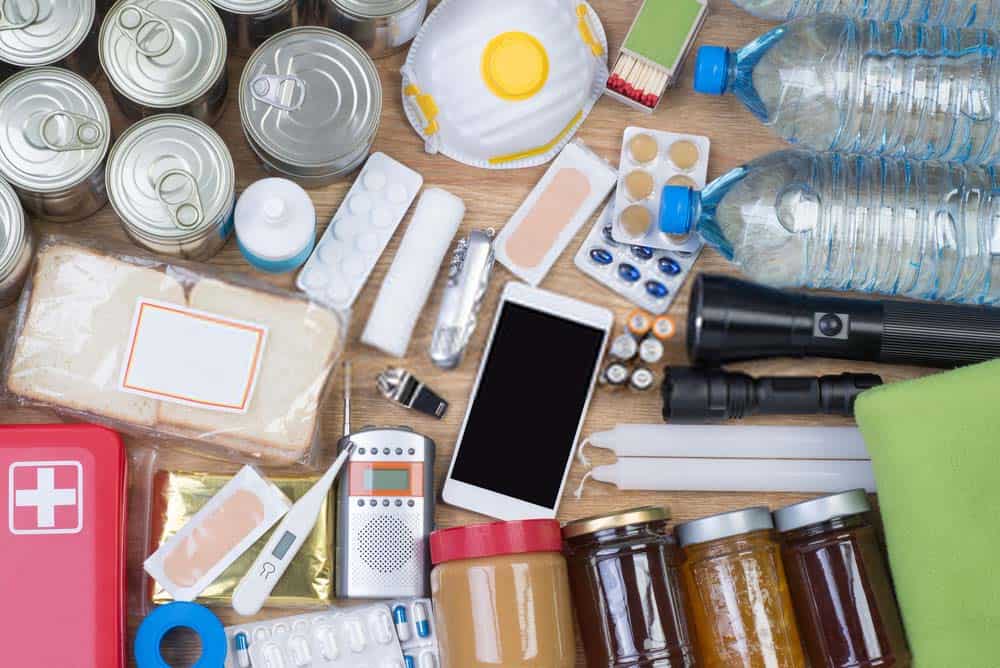
One of the main pillars of survival is sustenance. Without it, you will slowly die from starvation, making it the second most crucial thing after hydration. Calories are your life energy, so no matter the way they are present in your kit, they should be there in some form.
Most commonly found are packets of nuts, trail mixes, freeze-dried foods, dehydrated meals, energy bars, or gels.
Pemmican is another food solution for your kit. This survival snack was initially invented by the Native Americans hundreds of years ago to aid them. It’s rich in protein and can last decades without being in refrigeration.
You should stay off food with high-sugar content because even though it will give you a burst of energy, after a while, you are going to feel tired again. So, to sum it up, you should pack your survival kit with as many densely packed calories as you can, which takes as small of a space as possible.
Emergency Gear And Tools
The best survival kits out there have not only food and water but also some survivalist gear, clothing, and tools to help you stay safe in emergencies. But remember, you should consider only small, lightweight, and multifunctional tools that aren’t a burden to you if you need to change your location. They can include the following:
A Survival Knife
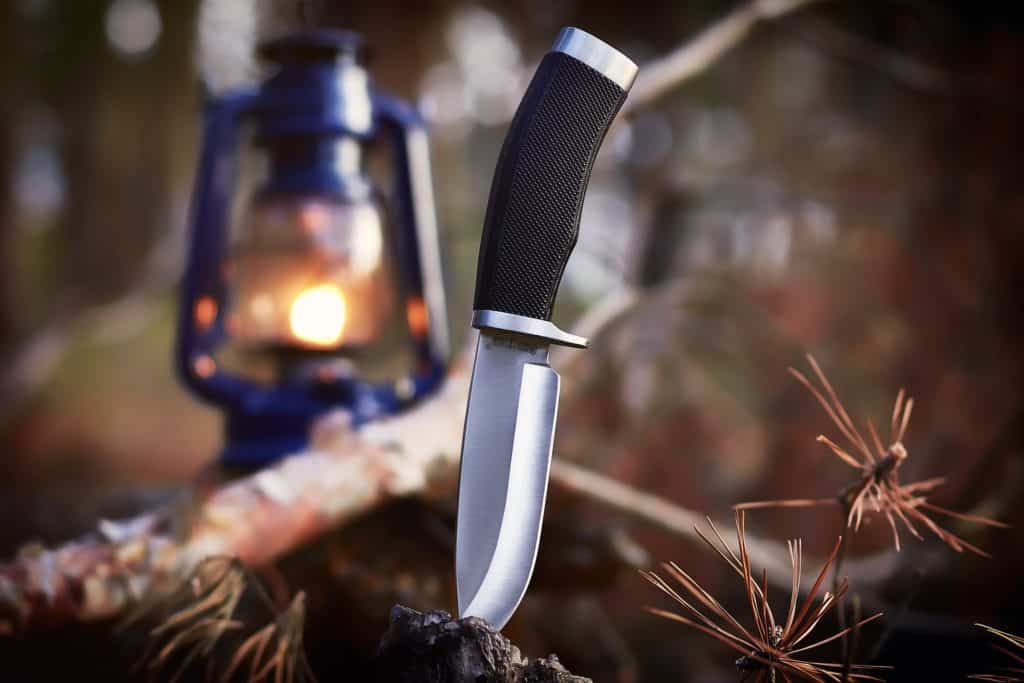
If you are knowledgeable in the art of bushcraft, you should consider something like a bushcraft knife through a normally sized survival knife or a credit card, one should do the job just right.
Knives have been one of man’s most essential tools since the earliest traces of the human race, and to this day, everyone should have at least one blade close at hand to help them in the most challenging situations.
So, the size of your survival knife depends on how much you will rely on it. If you are confident in your bushcraft knife skills, a bigger and heavier one is a viable option. You can even up the size and go full jungle warrior with a machete or a multi-use shovel. Still, if you aren’t experienced in using a blade, a smaller one shouldn’t have any significant drawbacks and will also leave more space for things that will be more useful to you.
Waterproof Striker, Matches, or a Lighter
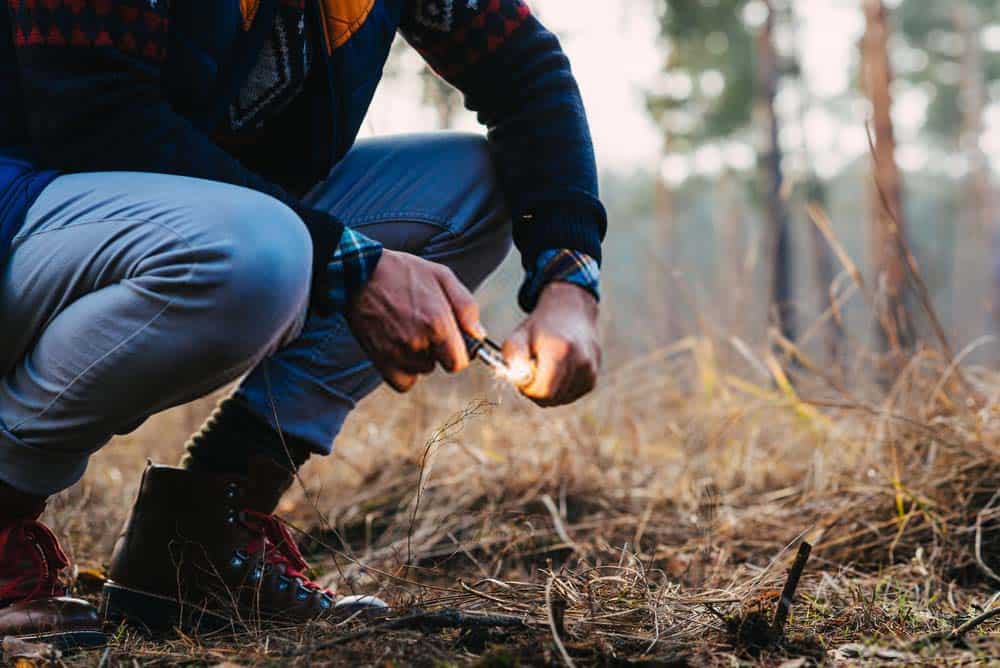
A way to light a fire is an essential way to keep a high level of preparedness. Since the dawn of time, the fire has given the man away to cook, to warm himself, and has been an essential source of light, so you should be able to access the gift of the red flower if you catch our drift.
The only three reliable ways of lighting a fire without wasting much time are with waterproof matches, a striker, or a lighter because even in a case of a flood, when you get to a dry place, you will still be able to light a fire. So, to wrap it up, a pack of the storm and waterproof matches shouldn’t ever leave your survival bags.
A First Aid Kit
A natural disaster can lead to anything, so a first aid kit should be no brainier. But don’t go overboard – you don’t need a full-sized emergency trauma kit – a small portable one is good enough.
Though you could encounter something like severe trauma, those big kits could take almost half of your survival kit bag. And even though you will be prepared for anything, you won’t have room for more useful things, like food and water provisions or blankets.
At the end of the day, whichever first aid kit you choose must include: band-aids, alcohol swabs, antibiotic ointment, and some clean gauze.
Compass
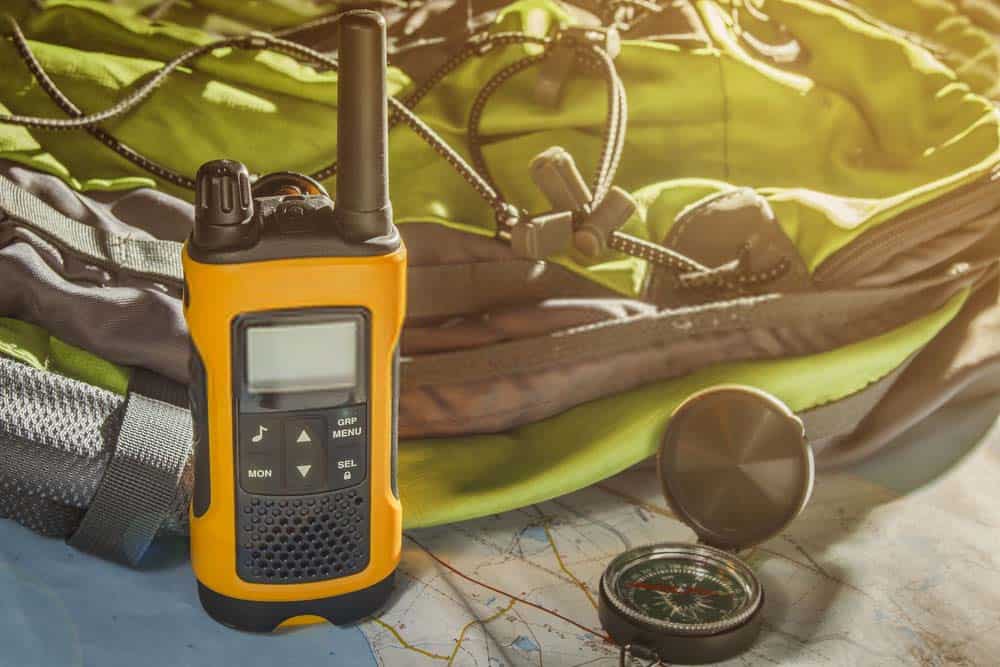
An excellent way to make a bad situation even worse is to get yourself lost, so a good compass is a thing, which your survival kit should include. But don’t go buying some high-tech military-class compass – you need a working one.
Survival Blankets
Space blankets, bivy sacks, or emergency blankets, whatever you may call them, are a must for every person using the kit.
They weigh almost nothing and don’t take up significant space because they are mostly thin foil but amazingly retain nearly 90% of your body heat. Their bizarre nickname comes from the fact that NASA initially designed them for their astronauts, but they work just as well for any emergencies on Earth.
Fishing Hook & Line
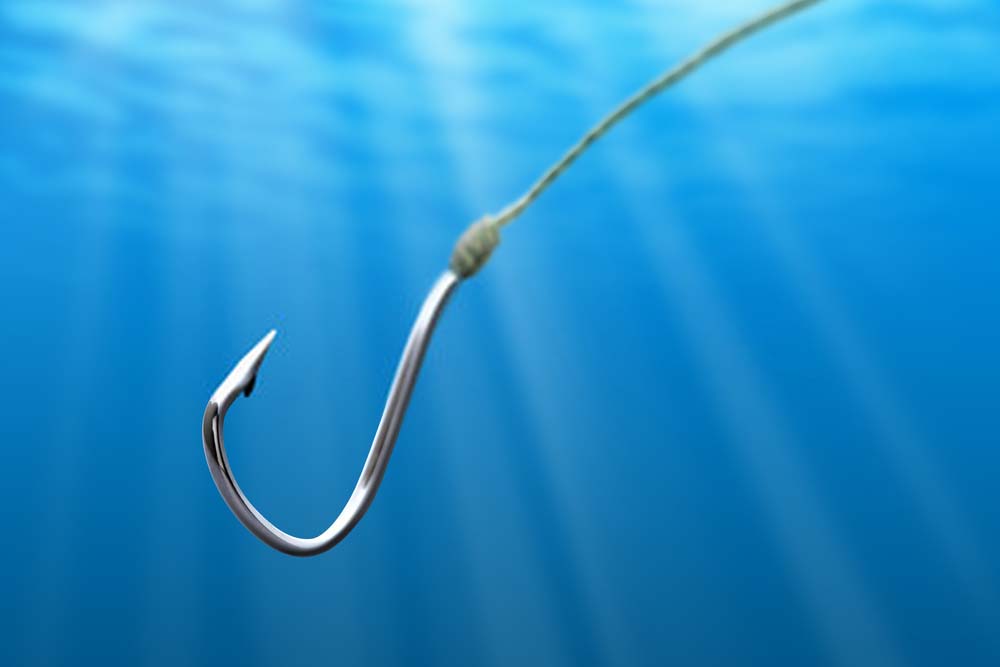
Let’s say you have packed enough food for your adventure, and everything is going well, but there will eventually come a time when your food will end. So what are you going to do – fish yourself some more. Fishing has been one of the most reliable ways of calorie acquisition. The sea creatures are a great source of protein and are easily prepared on your campfire.
But to catch some fish, you will need some lines and hooks. Bait is easily found in the wild, for example, worms, so this won’t be a problem. And you don’t need some expensive carbon alloy fishing rod. A typical strong stick and the components mentioned above are just enough.
Even more, a set of lines and some cords take just a little bit more space than your first aid or sewing kit, so don’t overthink it too much pack a lot of patience with you, and you will have a reliable way to find food for a long time.
Glow Sticks
Glow sticks are a lifesaver. Not only do they take up almost no space, but they are multifunctional. As a result, they can be used as both a last resort quick source of light and as a rescue beacon. So, a dozen glow sticks won’t cost you much now but could be a great asset later.
Duct Tape
There’s an old American saying, “If it doesn’t work with duct tape, just add more duct tape.” It can help you build and repair almost anything in an emergency. Of course, these days, there is the widely spread T-Rex duct tape, which is a weatherproof and stronger version of the original product and as useful as any other tool in your survival gear.
If you want to learn more on the subject, check our guide on ‘101 Ways To Use Duct Tape For Survival‘.
Survival Poncho
Hypothermia is one of the most common causes of death, so when it starts raining, you should have a way to stay dry. While you could always find or build a shelter, you never know when you will end up out in the open without a roof over your head. So, a good poncho that is easily collapsible and won’t give you any space management problems should be a definite inclusion in your emergency kit. A dry bag can be a good alternative to keep you dry.
Nitrile Gloves
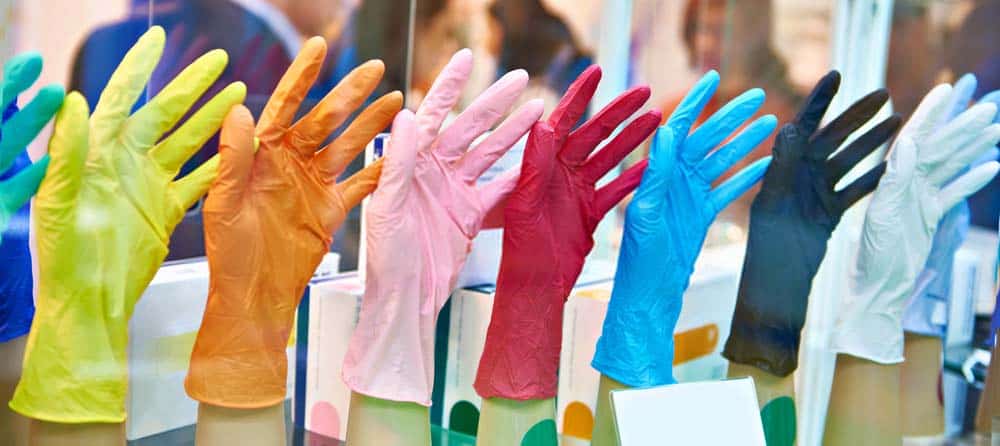
A pair of handy single-use gloves could be a perfect addition to your survival kit. They are sterile, which makes them great for working on injuries and open wounds. One pair of gloves can also help you deal with toxic materials or just nasty stuff you encounter.
And a couple of pairs won’t be much of a hassle, so make sure you tuck them in your survival bag for sure. If you have space, you should consider cold-weather gloves, too, especially for mountain use!
Dust Masks
Without air, you’ll suffocate in little to no time, so a cover to protect you from different gasses and particles is an irreplaceable tool in case of a fire, poisonous gasses, or even an earthquake. While you may consider a full-blown gas mask, it takes considerably more space than the dust masks usually found in department stores.
Suffice it to say – if you aren’t preparing for more dangerous chemicals, a single-use dust mask should do the job just right.
Emergency Whistle
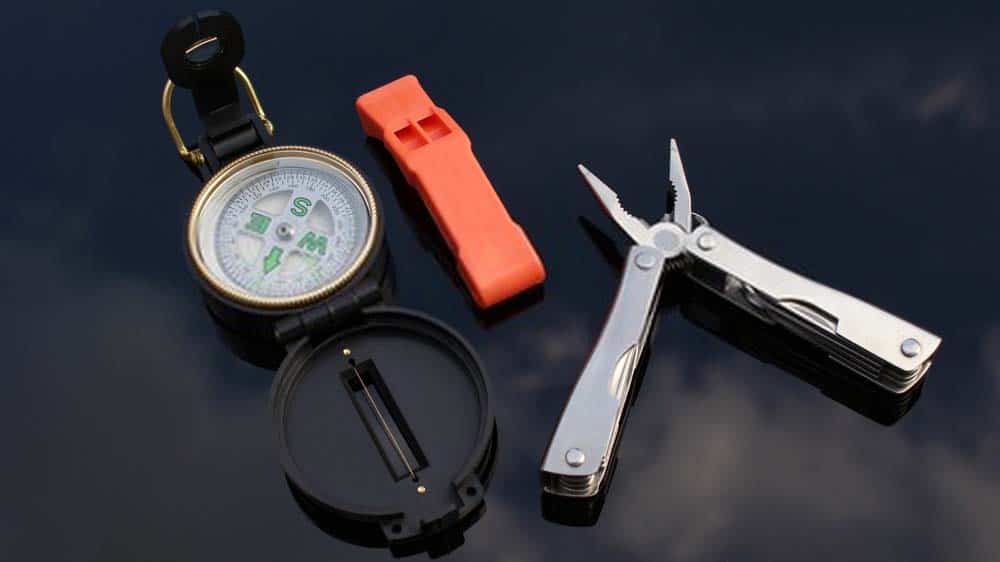
Even if you are a very loud person, you should carry an emergency survival whistle. While you may shout very loudly, sometimes only the high tones of the whistle can help you. Not only does it reach farther than any human voice, but you can also put it on your key chain and forget about it. So, no matter how confident you are in your voice, an emergency whistle will be a perfect topping to your survival kit ice cream.
Flashlight

Some may say that relying on battery-powered survival tools isn’t a brilliant idea. Still, a small, powerful flashlight can go a long way in helping you deal with an emergency. It should preferably be powered by AA batteries because you shouldn’t worry about specialized battery sizes in a critical situation. So definitely add a powerful Flashlight to your survival kit’s menu and store an additional battery to be sure.
Entertainment
Though it may sound like a bad idea to take up valuable space in your survival kit’s bag with things that will serve you only for show, your mental health is just as important as your body’s health. Your sanity is your most valuable asset in a critical situation. And while you may carry a bag full of useful survival kits, if you haven’t lost your mind in stressing about the case, they are just a pile of useless junk.
A deck of playing cards, a book, or a magazine is small enough not to eat up the space for food or water but will help you relieve some stress and start thinking straight again, no matter how dire the emergency is.
A Weapon
While you may get stranded out in the wild with no one around you, in some situations, you could find yourself attacked by evil people, so a way of self–defense should be of high priority. A pistol should be enough in almost any situation, so don’t go carrying any massive guns that will take up valuable space.
And don’t go out guns blazing on any suspicious people you see. Wasting ammo and starting needle conflicts is the last thing you want in an emergency.
Two-Way Radio
Most survival kits are made with the presumption that you can’t get any help, but if you are stranded in the wild and know your local ranger’s frequency, you should always have a way to at least try to get help. While some may prefer a pre-paid cell phone, a cellular connection isn’t always available, but with good two-way radio, you could still catch a signal to get some help.
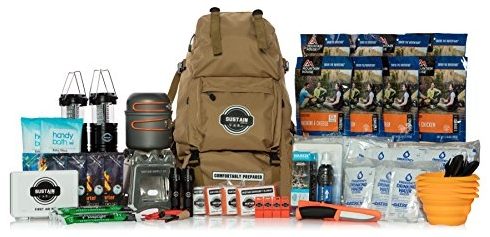
What about customization?
So you’ve packed away all the essentials, and now it’s time for items that are valuable specifically to you. For example, if you have diabetes, you should take a couple of insulin shots or any particular medications you may need.
People who wear contact lenses should always have a spare pair for a higher level of preparedness. You should also bring your preferred multifunctional tool with you, like a Swiss army knife. A journal to keep track of is a must for emergencies that prolong themselves.
If you still have enough space left, get your favorite survival book with you, an MP3 player full of your most treasured songs, and a picture of your family. Depending on how many additional items you add, you may still have some space left, so everything you think could help you – get so you won’t regret it later.
Suffice it to say a touch of originality can help you a lot in a critical situation. It would be best not to rely only on what’s included in sold premade kits because sometimes, only you know what’s best for you.
Frequently Asked Questions
How should you keep a survival kit?
Now that you’ve read through this long list of must-haves, there needs to be a way to store them. Depending on where you will use the kit and what outdoor activities, there are different containment units. They each have individual pros and cons, and we are going to list all of them to help you decide which is the best one for you. They are the following:
A Backpack
A survival backpack is a perfect solution for people who like larger survival kits and aren’t too concerned with how bulky the thing they are carrying is. So if you don’t care about how your survival kit is stored, just put it in the nearest backpack, and be sure that it will do the job just right. However, we highly advise you to get a backpack that’s water-resistant or waterproof so that it can withstand harsh weather conditions.
A Carrying Case
This is probably the most popular type of container for survival kits. They are divided into two major types – soft-sided and rigid ones. Soft-sided carrying cases are preferred because they are more lightweight, but if you store more fragile items, you should add some protection with a rigid one.
Whichever one you choose, they are both a proper container for your kit – small, with large volume, and easy to carry, so you can’t go wrong with them.
A Floating Bag
If your adventure involves water, a float bag or a usual waterproof bag is an irreplaceable addition. This carrying container can save your most valuable possession from getting wet or from drowning. The most common way of doing this is to put your kit in a standard carrying case and then in a floating bag, to add even more versatility to it.
Additionally, while you may think that color is just a cosmetic characteristic of your bag, it is one of the essential features of your containment bag. If you are stranded in the wild, a brighter and more reflective bag is a must-have, but in an urban setting, a more discrete pattern will be a more appropriate choice.
So an excellent way to adapt to your surroundings is to have a waterproof cover for your bag in a brighter color for emergencies in the wild, while your bag’s primary color will be a bit more urban-friendly.
Final Words
The Federal Emergency Management Agency, the American Red Cross, and the Centers for Disease Control and Prevention all have emergency supply lists on their websites. However, those lists can be intimidating in their breadth and their specificity. For the most part, a basic emergency kit isn’t hard to assemble, and there’s no such thing as a single kit that’s exactly right for everyone.
Whether lost in the woods, trying to keep safe during a flood, or lost in the outdoors, a survival kit should be in every person’s arsenal. Whether you make it yourself or you buy it online, with a little bit of customization, it will be the best thing you take with you during a crisis.
